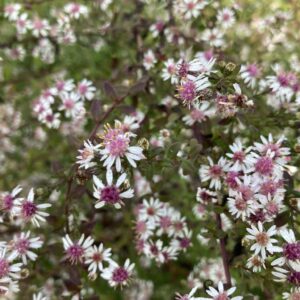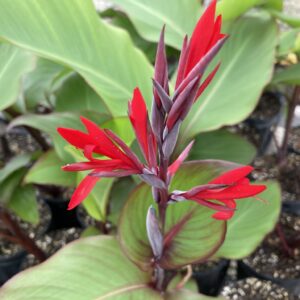"New" Heirloom Plants
Showing 1–8 of 62 results
-
Achlys triphylla Vanilla leaf, Sweet after death Z 5-9
A foot tall stem holds one large leaf divided into three, fan-shaped leaflets with deeply scalloped edges laying flat like a dinner plate. From spring to mid-summer an erect, white spike, not made of flowers, but made of stamens (the male part of plants that holds pollen) blooms.
A foot tall stem holds one large leaf divided into three, fan-shaped leaflets with deeply scalloped edges laying flat like a dinner plate. From spring to mid-summer an erect, white spike, not made of flowers, but made of stamens (the male part of plants that holds pollen) blooms.
Size: 8-16" x spreading by roots.
Care: shade to part shade in moist to moist well-drained soil
Native: mountains of the western US and Canadian coast up to nearly 5000’Natives of the Pacific Northwest used this medicinally to treat tuberculosis, cataracts, and induce vomiting, They also washed their hair with it and as an insecticide to repel or kill mosquitos, bedbugs and lice on sheep,
Both common names describe the sweet smell of its dried foliage. Collected by “Archibald Menzies on the west coast of North America.” Menzies (1754-1842) sailed on the Vancouver Expedition collecting many plants in 1787-1788. Cyclopedia or Universal Dictionary of Arts. Sciences, and Literature v. 20, p. (1812) where Sir James Edward Smith described and named it Loentic tripylla means Lion’s-leaf. Tripylla means three fruits. Renamed later. -
Anemone multifida Cutleaf anemone, Pacific anemone Z 2-6
Blooming in early summer small six petal-like sepals, watermelon pink, each with a center boss of sunny stamens with deep palmately divided basal leaves underneath.
Blooming in early summer small six petal-like sepals, watermelon pink, each with a center boss of sunny stamens with deep palmately divided basal leaves underneath.
Size: 9” x 6”
Care: part shade in humusy moist well-drained soil
Native: North America except the Arctic
Wildlife Value: hummingbirds build nests from seedheadsCollected by Drummond & Douglas west of the Rocky Mountains Blackfoot Indians called this “Looks-like-a-plume.” The burned seed-head inhaled to stop a headache. British Columbia’s Thompson Indians used this to stop nose-bleeds, calling it “Bleeding Nose Plant.” This red/pink one collected by C.C. Parry before 1860. Parry (1832-1890) tagged as the king of Colorado botany.
-
Arcanthemum articum Arctic daisy Z 3- ?
Closely-packed groundcover like a rug of small, classic white daisies with yellow centers.
Closely-packed groundcover like a rug of small, classic white daisies with yellow centers.
Size: 6-18” x spreading
Care: sun to part shade in moist well-drained to well-drained soil
Native: Western Canada to Alaska, North-east Europe to Japan
Wildlife Value: drought tolerantBy 1735
-
Armeria maritima Thrift, Sea pink Z 3-10
Petite pink balls from May to June atop grass-like foliage
Petite pink balls from May to June atop grass-like foliage
Size: 8” x 12”
Care: full sun, well-drained, moderately fertile soil
Native: North Atlantic coastsKnown to grow in the late Glacial period – around 10,000 BC. Common cottage garden flower since the reign of Queen Elizabeth 1st, 16th century. A favorite plant for knot gardens.
-
Aster laterifolius ‘Horizontalis’ syn Symphyotrichum laterifolius ‘Horizontalis’ Horizontal Calico Aster Z 4-8
Unique horizontally branching aster covered in small pink and white daisy-like flowers with dark pink centers blooming in late summer-fall. Foliage turns copper/purple in fall.
OUT OF STOCK
Unique horizontally branching aster covered in small pink and white daisy-like flowers with dark pink centers blooming in late summer-fall. Foliage turns copper/purple in fall.
Size: 24” x 24”
Care: full sun to part shade in well-drained soil
Native: Eastern and Central North America
Wildlife Value: attracts bees and butterflies. Deer resistant, Black walnut resistant.
Awards: RHS Award of Garden MeritFirst described by French botanist René Desfontaines (1750-1802). Harvard botanist Asa Gray named the variety in 1895.
-
Bouteloua curtipendula Sideoats grama Z 4-8
Narrow, blue-green leaves tinged purple or red in fall when golden oat-like seeds hang down one side of each leaf, eye-catching.
Narrow, blue-green leaves tinged purple or red in fall when golden oat-like seeds hang down one side of each leaf, eye-catching.
Size: 2-3' x 1'
Care: Sun in well-drained to moist well-drained soil, drought tolerant
Native: most of US, incl. Wisconsin
Wildlife Value: nesting material for butterflies and bees; larval host for some Skipper butterflies,
Awards: state grass of TexasKiowa natives who had killed an enemy in battle with a lance wore this. Collected and described by French planthunter André Michaux (1786-1802) who scoured Eastern North America west to the Mississippi over 11 years.
-
Campanula ochroleuca Bellflower Z 4-7
Ivory, rocket-shaped buds open to bell-like blossoms covered with fine hairs with five, flared petal-ends surrounding ivory stamens and pistil along erect to arching stems. Blooms June-July on slow-spreading, clump-forming rosettes of hairy, heart-shaped or triangular leaves.
OUT OF STOCK
Ivory, rocket-shaped buds open to bell-like blossoms covered with fine hairs with five, flared petal-ends surrounding ivory stamens and pistil along erect to arching stems. Blooms June-July on slow-spreading, clump-forming rosettes of hairy, heart-shaped or triangular leaves.
Size: 12-18” x 12-15”
Care: sun to part shade in moist well-drained to well-drained soil
Native: Caucasus
Wildlife Value: provides pollen to bees and butterflies, rabbit resistantFirst described in a published document in 1949.
-
Canna edulis Indian shot, Arrowroot Z 7-10, Tender Perennial
Several shoots of red, tube-like flowers atop a tall stalk , taller than its banana plant-like, broad, waxy, oval foliage, green with purple toward the top. Flower all summer.
Several shoots of red, tube-like flowers atop a tall stalk , taller than its banana plant-like, broad, waxy, oval foliage, green with purple toward the top. Flower all summer.
Size: 8’ x 3’ spreading
Care: sun in moist to moist well-drained
Native: Andes of South America, and the West Indies
Wildlife Value: attracts bees, hummingbirds and butterflies.
Size: Primarily grown as a root crop to eat, Roast or boil root like a potato. Root is source of arrowroot used as thickener.Edulis means edible.
Carbon dating of tubers shown grown more than 3500 years ago.In colder Zones, lift and overwinter indoors.
**LISTED AS OUT OF STOCK BECAUSE WE DO NOT SHIP THIS ITEM. IT IS AVAILABLE FOR PURCHASE AT OUR RETAIL LOCATION.



